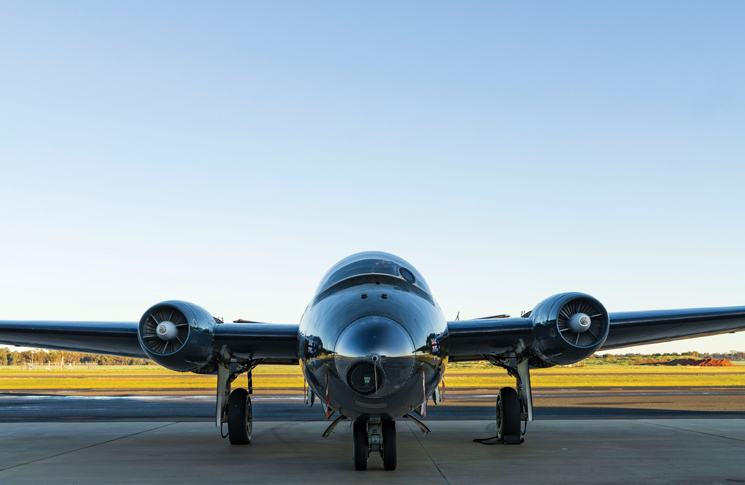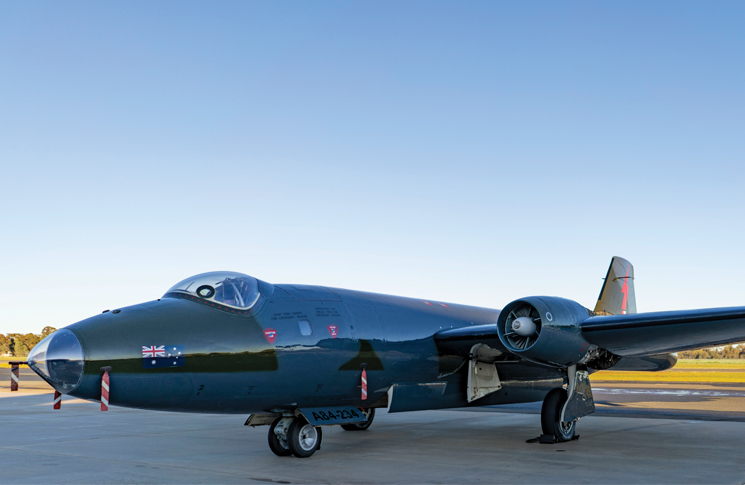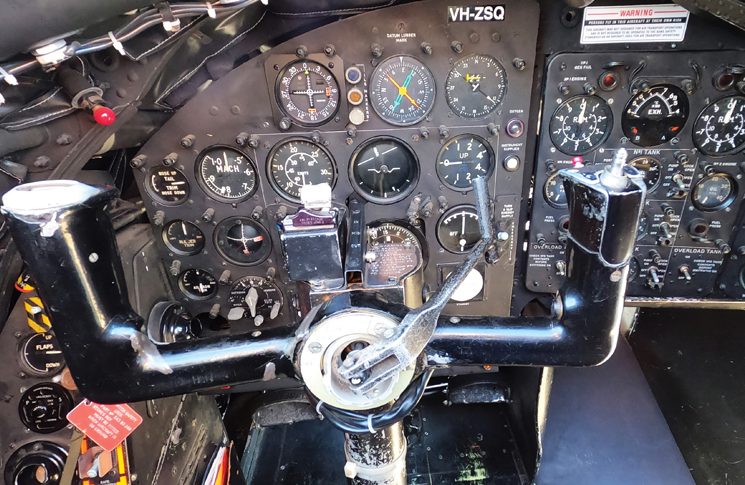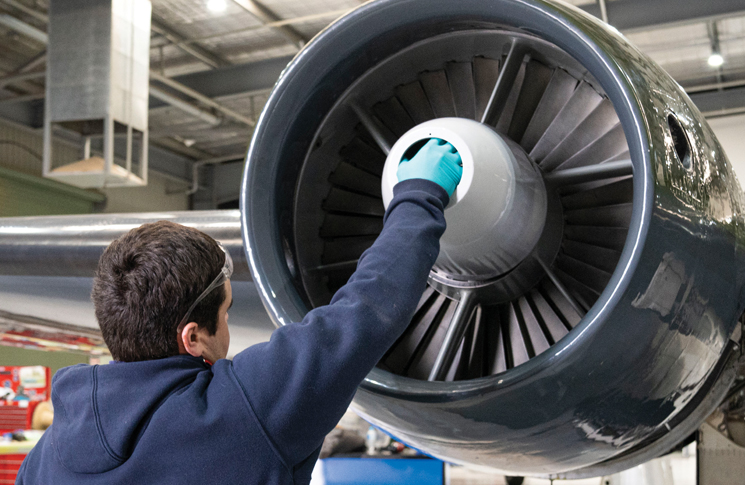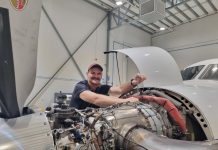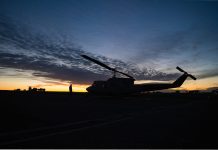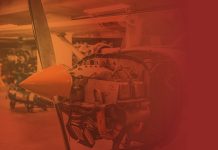The story of a warbird’s starter motor replacement illustrates the challenges and subtleties of keeping vintage aircraft safely in service.
In the northern Riverina of NSW there’s a place where millennial-generation apprentice engineers speak with knowledge and warmth about various marks of Spitfires, and in awed tones about the byzantine complexity of the Wright R-3350 radial engines of the Boeing B-29.
For aviation afficionados and cognoscenti it is a paradise on the plains. Three quarters of a century ago other similarly passionate young men learnt to fly at this very place before going to war over Europe and the Pacific.
Temora Aviation Museum is a world‑class collection of flying warbird aircraft from the 1930s to the 1960s. Necessarily, it is also a centre of maintenance expertise and innovation. The museum’s latest project is to return its English Electric Canberra bomber to the air.
Like many great aircraft, the Canberra comes from a simple concept. Design work for it began in 1944 with the brief to produce a turbojet version of the de Havilland Mosquito. Like that twin‑engine World War II fighter-bomber, it was to be unarmed but untouchable, with the ability to fly higher (55,000 feet in operational use, 7000 feet above the published ceiling) and faster than any pursuer. This was done, as in the Mosquito, by the combination of as small an airframe as possible with the most powerful engines of the day. An impressive bomb load was a bonus of this design philosophy.
The Canberra, which first flew in 1949 as a prototype, fitted its brief from the start and went on to have a 55-year service career: the first Canberra joined the British Royal Air Force (RAF) in 1951, the last was retired in 2006. More than 1000 were made in intervening years and served with air forces all over the world, including 49 Australian-constructed examples, some of which flew in the Vietnam war. Temora’s Canberra is a British-built ex‑RAF aircraft, painted in the colours of RAAF No. 2 squadron.
Temora Aviation Museum chief engineer Andrew Bishop describes the Canberra as ‘a beautiful aeroplane to look after, very robust in design’. But in common with most military aircraft, it was designed primarily to do a job, not last a long time. After decades in service an unanticipated hazard threatened its continuing airworthiness. The Canberra uses Coffman-type starters on its Rolls Royce Avon turbojets. These explosive cartridges start the engine literally with a bang and, in the 1940s, were a light, cheap and reliable way of starting large engines. What wasn’t appreciated at the time was how they damaged jet engines every time they fired up.
‘The problem with the cartridge start is the by-product of the explosion is very corrosive,’ Bishop says. ‘On start, the gas and residue shoot out the exhaust ports but, as the engine spools up, it gets sucked into the engine where it attacks the compressor blades.’
In service use, with the Avon engine’s short time between overhauls and a plentiful supply of replacements, this was not a crippling problem. But a rare and precious museum aircraft is in a different situation. Temora’s Canberra is the only flying example of the type.
Despite having a lifetime supply of cartridges in store—about 2500—the museum elected to fit an electric start at the aircraft’s last major service. ‘We did it to ensure the longevity of the engines for future use,’ Bishop says.
Luckily for the museum, later versions of the Rolls-Royce Avon used electric starters, but adapting these to the Canberra’s cartridge housing was anything but straightforward.
The starter is a 520-series Lucas Rotax from a de Havilland Comet 4C. It’s connected to an Avon Sabre planetary reduction gearbox and an Avon Sabre spring drive to the compressor. A power control system, enabling the starter motors to gradually spin up the turbine in five stages, came from a Canadian company, Lortie Aviation, (which supports a privately owned fleet of Avon-powered Hawker Hunters).
The next decision was whether the new system should be internally or externally powered. Starting the aircraft from a standard external power unit was not an option due to the Comet’s unique electrical architecture. ‘It uses 120-volts DC—who would do that? Turns out the Poms did in the 1950s,’ says a bemused Bishop.
‘We actually found a 120-volt start cart at Camden, but it was in pretty sad condition. Add to that, for visits to other aerodromes, the cart would have had to be carried in the bomb bay and a self-contained system began making sense.’ The Canberra’s bomb bay now carries 250 kg of batteries and power control avionics. ‘We had the aeroplane reweighed, and the batteries had no impact on C of G,’ Bishop says.
The Canberra’s restoration saga has lessons and resonances for any operator of vintage or ageing aircraft. ‘The thing we have learnt most about operating vintage aeroplanes is there’s no cheap, easy way of doing it,’ Bishop says, ‘It is hard work, takes a lot of research, consideration and dedication.‘
The thing we have learnt most about operating vintage aeroplanes is there’s no cheap, easy way of doing it.
An important part of preservation is appropriate use, bearing in mind the aircraft’s age. ‘This aeroplane is a 65-year-old aeroplane and we put measures in place to preserve it,’ Bishop says, ‘We don’t operate at high take-off weights or G loadings. We keep in calm air and avoid turbulence where we can.’
The Canberra’s long military service meant air forces discovered and fixed problems which would have been a museum operator’s problems if the aircraft had had a shorter front‑line career.
‘We are fortunate the RAF operated Canberras for many decades. As a result, they learnt where they break, crack or fail and developed inspection techniques.’
Non-destructive testing was refined over the Canberra’s service life, with eddy current, ultrasonic, X-ray and dye-penetrant tests assessed against reference blocks—sections of airframes cut from Canberras with known fatigue and corrosion problems. One set of these blocks now exists and was sent from England for the major service.
‘The museum has benefited from years of corporate knowledge,’ Bishop says, ‘but so can any aircraft operator by joining their type club.’

